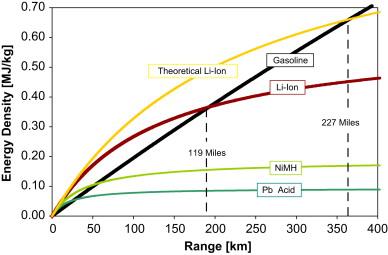Posts Tagged ‘cost’
16 May
Final Statement
17 Mar
Battery cost is as important as their energy
When different battery technologies are compared, one often falls back on a comparison of either energy, power or cycle life. While these are certainly important factors, it may not be enough to choose the battery type of the future. In this comparison, we will use the required power/energy as a constant and explore the other factors. This allows to evaluate different battery types in the same application.
The first factors that should be taken into account are volume and weight. This is a factor that is mostly described in terms of energy density, volumetric and/or gravimetric. The importance of the volume is fairly obvious since space in a (hybrid) electric vehicle is limited, certainly if you focus on an aerodynamic design. As stated in our previous blog-post, the weight is a factor that has a big effect on the range of an electric vehicle. Batteries with a high weight, and thus a high gravimetric energy density, can get a higher range for the same energy stored in the batteries. With these factors in mind, Lithium-Ion and Lithium-Polymer batteries have a huge advantage over traditional battery types such as Lead-Acid and Nickel-Metal Hydride.
While volume and weight are logical factors to consider and are often referred to in studies, the battery cost is often neglected. The Lithium-Ion battery technology was first released by Sony in 1991, over the last two decades huge increases in performance, safety and cycle-life have been achieved. While this are very important improvements, they all came with an increase of production cost. The result of these two decades of research is a very broad spectrum of possible combinations of energy density, cycle life and capacity. No one doubts that these batteries are improved since their first design, but the total improvement is only 8% to 10%. If you want to take the most advantage of these technologies however there is a serious price tag coming with it. The standard Lithium Ion batteries have a cost of $0,45 to $0,55 per Wh, high-end types have prices up to $1,50 per Wh. Lithium Polymer batteries are the cheapest alternative available with still a decent performance at $0,35 per Wh.
Lead Acid batteries exist for many years (their first appearance was around 250BC!), but until the late 1960’s, no significant improvements have been made. During the last three decades, a lot of research has been done by Axion in America and CSiro in Australia. The results of these studies are high-end Lead Acid batteries. Axion has developed a PbC-battery that claims an increase of 400% in power at a double of the cost of standard Lead Acid batteries: $0,20 to $0,30 per Wh. The CSiro research resulted in a so-called “ultrabattery”, which is a hybrid of a Lead Acid battery and a super capacitor. In a 100 000-mile test, the ultrabattery got a decrease in gas mileage of 2,8% over the original Nickel Metal Hydride battery pack, but this while saving $2000 in cost.
If we use this data to make a comparison between (hybrid) electric vehicles based on their battery choice and capacity, we see that the advantage of Lithium-batteries is smaller than thought. In table 1, an overview of the cost estimates for different battery packs has been made, and it is clear that for the same energy, Lead Acid batteries are a lot cheaper than their Lithium Ion counterparts.
| Battery Capacity (kWh) | Li-Ion Cost | Advanced PbA Cost | PbA Cost Advantage |
|---|---|---|---|
| 0,50 | $667 | $250 | $417 |
| 1.00 | $1,333 | $500 | $833 |
| 1.50 | $2,000 | $750 | $1,250 |
| 5.00 | $6,665 | $2,500 | $4,165 |
| 16.00 | $21,328 | $8,000 | $13,328 |
This difference in price plays an important role in the price of the electric vehicle; electronics and the power train are roughly the same for both designs, and thus the cost of the vehicle is largely related to cost of the battery pack. This difference can be seen in the following graph, depicting the cost of the different components of a vehicle and the total cost using either Lithium Ion or advanced Lead Acid batteries.
The conclusion of this blog post is that despite it might be too early to draw a final decision, the focus everyone seems to place on Lithium Ion batteries for the future seems to be a little bit hasty. The costs of the total should be taken into account when comparing the different technologies. Every technology will probably have its use, but for high power applications, Lead Acid shouldn’t be written of despite their higher weight/lower energy density.



